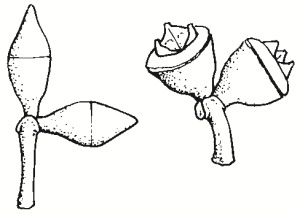Family:
Myrtaceae
Eucalyptus rubida
Candlebark
Other Names:

Name Origin:
rubida — from Latin rubidus, red, referring to seasonally red bark patches. Common name refers to bark appearance.
Regional Subspecies:
Eucalyptus rubida subsp. rubida
Similar Species:
Distinguish from Manna Gum (E. viminalis) mainly by juvenile foliage.
Occurrence:
Regional:
Widespread in the higher rainfall areas generally east of the Hume Highway.
Australia:
NSW, Vic, Tas, SA.
Habitat:
Moderately fertile, well-drained loams with clay subsoil, in foothills and tablelands. Also mountain slopes and upper river valleys.
Habit:
Tall tree with straight, largely bark-free trunk, 20-30 m high.
Site Preference:
Well-drained soil. Resists cold, frost, wind and moderate drought.
Characteristics:
Moderate growth rate. Foliage has distinctive aroma.
Flowering:
White, Dec-Apr.
Seed Collection:
Throughout year, particularly Feb-May.
Propagation:
From seed (± 220 viable seeds per gram). Optimum germination temperature 27°C.
Regeneration:
From seed, particularly in the absence of competitive exotic grasses or weeds, and during wet summers.
VALUES:
Shade & Shelter:
Useful medium to high level cover in windbreaks.
Wildlife:
Excellent habitat. Hollows important nest sites for many native birds and mammals. Rosellas eat capsules and seeds. Koalas occasionally eat foliage. Flowers and nectar are a food source for various native birds, insects and mammals.
Fuel:
Useful, although burns quickly.
Timber:
Timber tough, moderately hard and strong. Not durable. Density about 760 kg/m3. Occasionally used for fencing and firewood, but generally regarded as second-rate building timber. Potential for joinery, flooring and parquetry.
Ornamental:
Attractive for larger gardens and parks. White trunk, interesting juvenile foliage and pink bark streaks in late summer are features.
Other:
Leaves produce yellow dye with mordant alum.
